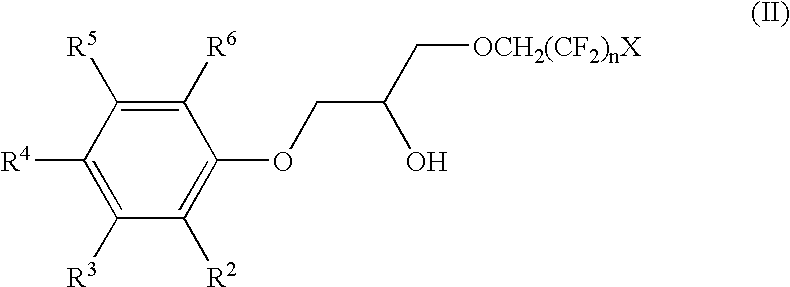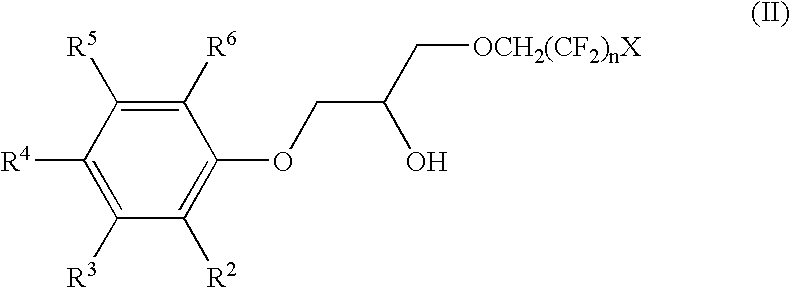Fluoro-alcohol phase modifiers and process for cesium solvent extraction
a technology of phase modifiers and fluoroalcohol, which is applied in the direction of inorganic chemistry, water/sewage treatment by ion exchange, nuclear engineering, etc., can solve the problems of nuclear energy complexes and treatment sites with environmental problems, desorption of cesium, and complete satisfactory treatment technologies
- Summary
- Abstract
- Description
- Claims
- Application Information
AI Technical Summary
Benefits of technology
Problems solved by technology
Method used
Image
Examples
examples 1-4
General Procedure for the Synthesis of Modifiers Cs-6, Cs-7TB, Cs-7SBT, and Cs-7TA
The phenoxy fluoro-alcohols Cs-6 (1-(2,2,3,3-tetrafluoropropoxy)-3-(4-tert-octylphenoxy)-2-propanol), Cs-7TB (1-(2,2,3,3-tetrafluoropropoxy)-3-(4-tert-butylphenoxy)-2-propanol), Cs-7SBT / Cs-7SB (1-(2,2,3,3-tetrafluoropropoxy)-3-(4-sec-butylphenoxy)-2-propanol), and Cs-7TA (1-(2,2,3,3-tetrafluoro-propoxy)-3-(4-tert-amylphenoxy)-2-propanol) (FIG. 12) are prepared from the reaction of glycidyl 2,2,3,3-tetrafluoropropyl ether and the respective alkylphenol. To a stirred solution of the appropriate alkylphenol (0.20 mol) and ground potassium carbonate (0.023 mol) in 95% ethanol (140-150 mL) at 60.degree. C. under argon was added neat glycidyl 2,2,3,3-tetrafluoropropyl ether (0.21 mol) dropwise neat via pressure-equalizing addition funnel over the course of approximately ten minutes. The reaction mixture was brought to a gentle reflux, and the progress of the reaction monitored using TLC (SiO.sub.2 ; 80 / 20 he...
example 1
1-(2,2,3,3-Tetrafluoropropoxy)-3-(4-tert-octylphenoxy)-2-propanol, Cs-6.
Prepared from 4-tert-octylphenol. Yield 93% (after vacuum distillation at 163-166 .degree. C. at 0.20-0.25 mmHg) of a colorless oil. The product has the following characteristics. .sup.1 H NMR (400.13 MHz, CDCl.sub.3): 0.72 (s, 9H, (CH.sub.3).sub.3 CCH.sub.2 C(CH.sub.3).sub.2 --), 1.35 (s, 6H, (CH.sub.3).sub.3 CCH.sub.2 C(CH.sub.3).sub.2 --), 1.71 (s, 2H, (CH.sub.3).sub.3 CCH.sub.2 C(CH.sub.3).sub.2 --), 2.56 (d, J=4 Hz, 1H, OH; note: the hydroxyl proton is "mobile"), 3.77 (m, 2H, ArOCH.sub.2 CH), 3.76 (m, 2H, ArOCH.sub.2 CH), 3.92 (t of t, J.sub.HF =12.6, 1.6 Hz, 2H, --CH.sub.2 OCH.sub.2 CF.sub.2 CF.sub.2 H), 4.01 (m, 2H, --CH.sub.2 OCH.sub.2 CF.sub.2 CF.sub.2 H), 4.17 (m, 1H, ArOCH.sub.2 CH), 5.91 (t of t, J.sub.HF =53, 4.8 Hz, 1H, --CH.sub.2 OCH.sub.2 CF.sub.2 CF.sub.2 H), 6.83 (d, J=8.7 Hz, 2H, ArH2, ArH6), 7.28 (d, J=8.7 Hz, 2H, ArH3, ArH5); .sup.13 C{.sup.1 H} (100.61 MHz, CDCl.sub.3): 31.6, 31.7 (methyl g...
example 2
1-(2,2,3,3-Tetrafluoropropoxy)-3-(4-tert-butylphenoxy)-2-propanol, Cs-7TB
Prepared from 4-tert-butylphenol. Yield 88% (after vacuum distillation at 141-145.degree. C. at 0.20-0.25 mmHg) as a colorless oil. The product has the following characteristics. .sup.1 H NMR (400.13 MHz, CDCl.sub.3): 1.31 (s, 9H, (CH.sub.3).sub.3 C--), 2.62 (br s, 1H, OH), 3.78 (m, 2H, ArOCH.sub.2 CH), 3.93 (t of t, J.sub.HF= 12.6, 1.6 Hz, 2H, --CH.sub.2 OCH.sub.2 CF.sub.2 CF.sub.2 H), 4.02 (m, 2H, --CH.sub.2 OCH.sub.2 CF.sub.2 CF.sub.2 H), 4.18 (m, 1H, ArOCH.sub.2 CH), 5.92 (t of t, J.sub.HF =53, 4.8 Hz, 1H, --CH.sub.2 OCH.sub.2 CF.sub.2 CF.sub.2 H), 6.86 (d, J=8.7 Hz, 2H, ArH2, ArH6), 7.32 (d, J=8.7 Hz, 2H, ArH3, ArH5); .sup.13 C{.sup.1 H} (100.61 MHz, CDCl.sub.3): 31.4 (CH.sub.3).sub.3 C--), 34.0 (CH.sub.3).sub.3 C--), 68.4 (t, J.sub.CF =28 Hz, --CH.sub.2 OCH.sub.2 CF.sub.2 CF.sub.2 H), 68.6 (--CH.sub.2 OCH.sub.2 CF.sub.2 CF.sub.2 H), 69.1 (ArOCH.sub.2 CH), 73.4 (ArOCH.sub.2 CH), 109.2 (t of t, JCF=249, 35 ...
PUM
| Property | Measurement | Unit |
|---|---|---|
| Molar density | aaaaa | aaaaa |
| Molar density | aaaaa | aaaaa |
| Molar density | aaaaa | aaaaa |
Abstract
Description
Claims
Application Information
 Login to View More
Login to View More - R&D
- Intellectual Property
- Life Sciences
- Materials
- Tech Scout
- Unparalleled Data Quality
- Higher Quality Content
- 60% Fewer Hallucinations
Browse by: Latest US Patents, China's latest patents, Technical Efficacy Thesaurus, Application Domain, Technology Topic, Popular Technical Reports.
© 2025 PatSnap. All rights reserved.Legal|Privacy policy|Modern Slavery Act Transparency Statement|Sitemap|About US| Contact US: help@patsnap.com



